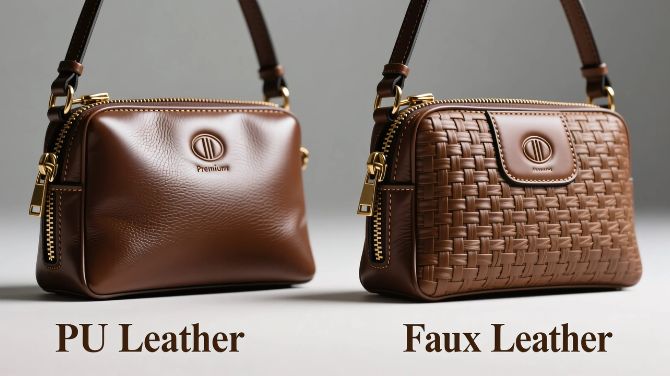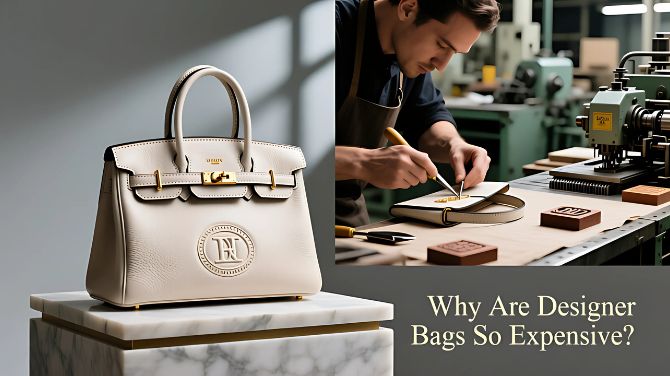Buying a handbag and wondering about PU leather vs faux leather can be confusing. Words like “vegan leather” or “leatherette” do not always explain the difference. A bag may look great online, but you do not know if it is PU leather or cheap faux leather. If you choose wrong, it could peel, crack, or lose shape in a few months.
This guide on PU leather vs faux leather will make it easy. You will learn the differences, the pros and cons, how to care for your bag, and how to pick one that fits your style, daily use, and budget. By the end, buying a handbag will feel simple and stress-free.
Handbags are more than just bags. They hold your things, show your style, and sometimes become your favorite piece. The material matters. PU leather and other faux leathers feel different, wear differently, and handle daily use in different ways. Some feel soft at first but lose shape fast. Others are firmer but last longer. If you care about the environment, knowing the material can help you make a smarter choice.
The main point is simple: PU leather is one type of faux leather, but not all faux leather is PU. Knowing this can save you money, time, and frustration.
This guide on PU leather vs faux leather will explain what PU leather is, how it compares with other faux leather, tips for buying and caring for your bag, cost and value, and environmental impact. By the end, you will feel confident picking the right handbag.
PU Leather vs Faux Leather: Quick Summary Table
If you are in a hurry, here is a snapshot of the main differences:
| Material | Feel | Durability | Price | Best Uses | Breathability | Maintenance | Longevity |
| PU Leather | Soft and smooth | Medium to high | Moderate | Everyday fashion bags, office bags | Medium | Easy | Good |
| Other Faux Leather | Varies | Medium | Low to moderate | Trendy, seasonal, budget handbags | Low to medium | Easy | Fair |
Quick Recommendations
- Everyday fashion bags: PU leather, especially mid-range to premium.
- Trend-focused, budget-friendly pieces: Other faux leather.
- Avoid: Cheap, low-quality faux leather with strong chemical smells or thin backing.
Tip: If you want your handbag to last several years and still feel premium, stick to PU leather or mid-range faux leather with strong backing.
Pu Leather vs Faux Leather
Confused between PU leather and other faux leather? Let’s break down the key differences so you can choose the right bag

Definitions and Terminology
Leather terms can be confusing. Knowing these terms is key to shopping smart.
Faux Leather
Faux leather is the general term for synthetic alternatives to animal leather. It includes PU leather and other types, often called “vegan leather” or “leatherette.”
These labels do not guarantee durability, quality, or eco-friendliness. Many budget handbags use cheap faux leather that peels, cracks, or feels stiff after a few months.
PU Leather
PU stands for polyurethane. This leather is made with a fabric base, usually cotton or polyester, coated with a thin polyurethane layer. This coating is embossed to mimic real leather.
- Softness and flexibility: High-quality PU feels soft to the touch, bends easily, and does not crease permanently.
- Appearance over time: Premium PU can develop a subtle shine or patina, similar to natural leather.
- Breathability: PU allows some airflow, keeping your bag interior dry and reducing odors.
- Edge resilience: PU edges fray less than cheap faux leather.
Other Faux Leather
Other faux leather is often made from thin plastic sheets. It can feel stiff and shiny and is less durable. Budget handbags frequently use these materials. They are less breathable and prone to cracking, peeling, and discoloration.
Why This Matters
Many shoppers confuse PU leather with other faux leather. PU usually feels more realistic, is more flexible, and lasts longer. Knowing this difference prevents wasted money and disappointment.
Pro Tip: Some brands use terms like “premium vegan leather” or “eco-faux leather.” Always check the backing because it could be PU, cheap PVC, or a mix.
Why the Distinction Matters
Confusing PU leather with generic faux leather is very common. Many bags labeled “vegan leather” are actually low-quality plastics. Understanding the difference saves frustration, disappointment, and frequent replacements.
Quality Indicators to Look For
- PU coating thickness: Thicker layers last longer and resist peeling.
- Fabric backing: Cotton backing is stronger and more flexible than polyester.
- Embossing: Realistic grain patterns show quality. Flat prints often indicate cheap faux leather.
- Tags: Look for PU or leatherette and check the backing.
Mini Case Study
Lina bought a bag labeled “vegan leather” at a fast-fashion store. The thin faux layer started peeling in three months. Her friend invested in a mid-range PU bag from Fossil. Three years later, it still looked soft, structured, and polished.
How Each is Made?
Want to know why some handbags last and others peel fast? It all comes down to how the leather is made.

PU Leather Production
- Base Fabric: Usually cotton, polyester, or microfiber. Thicker cotton improves durability and flexibility.
- Foam Layer: Adds structure and cushioning for a luxurious feel.
- Polyurethane Coating: Gives the leather-like surface and color.
- Embossing Rollers: Create texture that mimics natural leather grain.
- Finishing: Enhances water resistance, sheen, and longevity.
High-end PU uses thick fabric, multiple layers, and a soft flexible feel. Low-end PU has thin polyester backing and can peel easily.
Faux Leather Production
- Uses thin synthetic sheets.
- Stiff, less flexible, and prone to peeling or cracking.
- Often found in budget handbags and seasonal fashion pieces.
Mini Case Study
A shopper compared two PU totes: one high-end with cotton backing, soft foam, and embossed texture; one cheap PU with polyester backing. After one year, the high-end PU looked nearly new. The cheap PU showed creases and cracking..
Quality Levels in Handbags
Not all handbags are made the same. Let’s break down the quality levels so you know what lasts and what doesn’t.
- Low-end PU: Thin coating, creases easily, lifespan 1 to 3 years.
- Mid-range PU: Thicker coating, moderate breathability, lifespan 3 to 7 years.
- Premium PU: Multiple layers, soft feel, up to 10 years.
- Other Faux Leather: Stiff, less durable, prone to peeling and discoloration.
Mini Case Study
Sarah bought a cheap PU tote. Six months later, the straps cracked and corners peeled. Her friend chose a mid-range PU satchel. Three years later, it still looked soft, structured, and polished.
Tip: For everyday use, mid-range to premium PU is the best choice.
Look and Feel
How a bag looks and feels can tell you a lot about its quality. Let’s see what to watch for.

- Premium PU: Soft, smooth, flexible, subtle grain.
- Cheap PU: Plasticky, creases easily, dull finish.
- Other Faux Leather: Stiff, shiny, sometimes with chemical smell.
- Breathability: PU allows airflow, keeping the interior dry. Cheap faux leather can trap heat and moisture, causing odors or mildew.
Mini Case Study
Rina bought a PU crossbody bag from Michael Kors. After two years, it retained color, texture, and shape. Her colleague’s cheap faux leather bag started peeling within eight months.
Practical Tip: Run your fingers along seams. If it feels stiff or plasticky, it is likely low-quality faux leather.
Durability and Longevity

Some bags last for years, others fall apart fast. Let’s see what makes the difference.
- PU leather resists everyday wear. Low-quality PU may peel. Premium PU can last up to ten years.
- Other faux leather usually fails sooner, especially at folds or stress points.
- Sunlight and Wear: PU can fade slightly. Cheap faux leather may warp, yellow, or crack. Minor scratches on PU can often be repaired. Cheap faux leather is difficult to fix.
Mini Case Study
Priya bought a budget faux leather sling bag. Within a year, the surface peeled. Her friend invested in a premium PU crossbody. Three years later, it still looked clean, flexible, and polished.
Tip: Rotate your bags regularly. Even premium PU wears faster if used every day.
Maintenance and Cleaning
Taking care of your bag keeps it looking great. Here’s how to clean and maintain it easily.

Daily Care
- Wipe with a soft cloth every few days.
- Avoid rough surfaces or sharp objects.
- Keep out of direct sunlight and away from heaters.
Stain Removal
- Blot spills immediately.
- Mild soap and water work for most stains.
- For ink or tough stains, use PU-safe cleaners. Avoid bleach or alcohol.
Mildew Prevention
- PU resists mildew, but moisture inside a closed bag can cause odors.
- Keep dry. In damp climates, occasionally wipe interiors with a mild vinegar solution.
Travel Tips
- Use a dust bag or rain cover.
- Avoid leaving bags in a hot car. High heat can warp or peel PU.
Mini Case Study
Anya spilled coffee on her PU backpack. She blotted and cleaned it with mild soap and water. The bag recovered perfectly. Her friend’s cheap faux leather tote absorbed rain and started peeling within weeks.
Pro Tip: Rotate bags to reduce stress on straps and corners. Straps and zippers are often the first parts to show wear.
Cost and Value
PU leather is a sweet spot between cost and quality. It is not as cheap as some faux leather, but it is far more durable and visually appealing.

Price Tiers
- Low-end PU / cheap faux leather: $15 to $50. Short lifespan. Suitable for seasonal fashion.
- Mid-range PU: $50 to $150. Balanced durability and style. Perfect for everyday use.
- Premium PU: $150 to $400 or more. Multiple layers, soft touch, long-lasting, and stylish.
Why Investing in PU Makes Sense
- Cheap faux leather may need replacement every six to twelve months.
- Mid-range PU often lasts three to seven years. Premium PU can last up to ten years.
- One premium PU bag can outlast multiple cheap faux leather bags, saving money in the long run.
Brand Examples
- Fossil: Premium PU with durable backing and soft finishes.
- Michael Kors and Coach: PU and genuine leather options. PU lines feel luxurious and last years.
- Zara, H&M: Trendy, budget-friendly PU bags; best for seasonal fashion, not heavy use.
Tip: Quality matters more than price. A higher-cost PU bag may save money over time compared to replacing cheap faux leather repeatedly.
How to Spot Quality When Shopping
Knowing how to identify high-quality PU leather versus other faux leather can save you from disappointment. Here are practical ways to check:

Touch Test
- Flex the bag gently. High-quality PU bounces back easily. Cheap faux leather stays stiff.
- Feel the coating. It should be soft and smooth, not plasticky.
Visual Cues
- Look for embossed grain patterns. This indicates attention to detail.
- Check seams. Avoid bags with peeling, uneven edges, or thin backing.
Label Reading
- PU leather is usually labeled as polyurethane-coated textile.
- Faux leather or leatherette could be PU, PVC, or a mix. Always inspect the backing.
At-Home Quick Checks
- Smell test: PU leather has a mild synthetic smell. A strong chemical odor may indicate cheap faux leather.
- Water droplet test: Place a tiny drop of water. High-quality PU slightly absorbs it. Cheap faux leather beads water or warps immediately.
- Avoid burn tests for safety.
Mini Case Study
Rhea went shopping for a PU handbag. She squeezed the sides, inspected the grain, and checked the backing. She avoided two cheap faux leather bags that looked shiny but stiff. The PU bag she chose was soft, flexible, and lasted three years without peeling.
Frequently Asked Questions
Practical Shopping Tips
Buying the right bag doesn’t have to be tricky. Here are some easy tips to shop smart.
Determine Intended Use
- Everyday handbag: Mid-range or premium PU.
- Trendy, seasonal bag: Budget faux leather is fine.
Check Bag Structure
- Inspect edges, seams, and lining. Premium PU keeps its shape longer.
- Check straps, zippers, and hardware quality.
Flex the Material
- Soft, flexible leather is better. Avoid stiff, plasticky surfaces.
Look for Embossing
- Grain texture adds realism and durability. Flat surfaces often indicate cheap faux leather.
Consider Brand Reputation
- Fossil, Michael Kors, and Coach are known for premium PU.
- Zara, H&M, and other fast-fashion brands often use cheap PU or other faux leather.
Rotate Your Bags
- Using one bag every day accelerates wear. Rotate for longer life.
Always Check Labels
- Look for PU leather or leatherette with detailed backing info. Avoid generic “vegan leather” without details.
Mini Case Study
Meera bought a PU tote from Michael Kors. She rotated it with two other bags. After four years, it still looked soft, structured, and polished. Her friend bought a cheap faux leather tote from a local store. Within eight months, it started peeling.
Must Check: Why Are Designer Bags So Expensive?
Environmental and Sustainability Considerations
Your handbag choice can affect the planet. Let’s see which materials are smarter for the environment.

PU Leather
- Synthetic but less polluting than PVC.
- Does not involve animal products.
- Can be recycled in some cases, depending on backing material.
Faux Leather
- Often plastic-heavy.
- Less biodegradable.
- Chemicals used in cheap faux leather can be harmful to soil and water.
Practical Tip: If sustainability matters, invest in mid-range to premium PU leather. It lasts longer and reduces the need to replace bags frequently, lowering overall environmental impact.
Conclusion and Final Recommendations
PU leather is the sweet spot for handbags: soft, durable, stylish, and reasonably priced. Other faux leather works for budget or seasonal pieces but often disappoints quickly.
Checklist for Buying a PU Handbag
- Determine intended use and style.
- Balance budget and longevity.
- Check labels, backing, and material type.
- Flex the material and inspect seams.
- Choose mid-range to premium PU for everyday use.
Mini Case Study Recap
- Sarah’s cheap PU tote → failed in six months.
- Mid-range PU satchel → lasted three years.
- Anya’s PU backpack → survived spills and rain.
- Investing in quality PU pays off in durability, style, and daily practicality.
By following these tips, you can confidently choose a handbag that lasts, looks good, and suits your lifestyle. Investing in high-quality PU leather saves money in the long run, avoids frustration, and makes handbag shopping simple and enjoyable.



